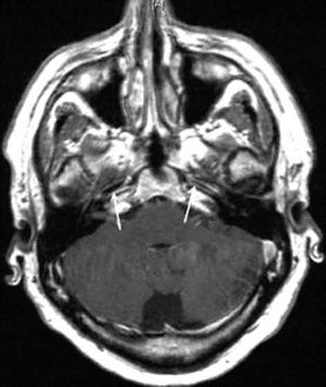Fig. 18.1
(a) Axial T1-weighted gadolinium-enhanced MRI showing the presence of a solid nodule with a diameter of 1.5 cm in the right parietal cortex with vasogenic edema. (b) Axial T2-weighted image demonstrating the presence of marked vasogenic edema surrounding a hypointense central nodule (From Erdem et al. [8])

Fig. 18.2
Contrast-enhanced axial T1-weighted MRI in a 56-year-old man with cranial nerve neuritis. Note the presence of bilateral enhancement of the CN VIII after gadolinium administration (arrowhead) (From Jochum et al. [13])
18.4 Treatment
The intracellular location of the bacteria may pose problems in the treatment of brucellosis. The optimal regimen is not uniformly accepted. Adequate CSF levels may not be achieved for tetracycline and aminoglycosides. The recommended dose of doxycycline accepted by most authorities is 100 mg orally twice a day combined with two or more other drugs (rifampin 600–900 mg orally once a day/streptomycin 1 g intramuscular once a day) and treatment has to be continued for a few weeks as per the response of the patient. Doxycycline crosses the blood-brain barrier better than generic tetracycline, and with trimethoprim-sulfamethoxazole and rifampin, better and more successful response has been seen for Brucella meningitis. Other drugs like 3rd-generation cephalosporins have high penetration to CSF but sensitivity and response of Brucella spp. is variable, and in vitro sensitivity should be ensured before using it. Antibiotic treatment has to be given for 1–19 months and CSF should be cleared. Steroids are to be used and are recommended for neurobrucellosis treatment, but the efficacy has not been proved in the absence of controlled studies. All patients are to be kept under review for 1 year after the completion of antibiotic treatment and the serum agglutinins has to fall to normal levels [1].
18.5 Prognosis
Meningitis caused by Brucella differs from other chronic meningitis as it has a better prognosis. Mortality in brucellosis is low for unknown reasons, and death has not been always clearly related to brucellosis. There has been high incidence for minor sequelae and only a few cases have suffered important limitations in their daily activity due to various motor, sensory, or intellectual deficits.
In cases of neurobrucellosis, the CNs usually remain affected permanently to some extent. Treatment usually does not cure the damage to the CNs, although little improvement may be seen after completion of treatment; however, in a few cases, complete resolution has been reported where diagnosis was made early and treatment was started early. This complete resolution has been reported in cases with involvement of CN VIII or VI and even in involvement of other CNs [14].
Conclusion
The most frequently observed complication in neurobrucellosis is meningitis yet it has many complications which may be in the form of meningoencephalitis, myelitis, CN paralyses, radiculopathy, and neuropathy. Basal meningitis may involve one or more CNs and this may be noted in more than half of the patients with neurobrucellosis. Tests which may be like serum agglutination are often used for screening but the confirmatory tests are complement fixation and Coombs’ test. The more sensitive and specific test for Brucella is ELISA. Treatment is needed for a long period of time and early diagnosis with early treatment may prevent many long-term complications.
References
1.
2.
3.
Al-Sous MW, Bohlega S, Al-Kawi MZ, Alwatban J, McLean DR (2004) Neurobrucellosis: clinical and neuroimaging correlation. AJNR Am J Neuroradiol 25:395–401PubMed
4.
Baldi PC, Araj GF, Racaro GC, Wallach JC, Fossati CA (1999) Detection of antibodies to Brucella cytoplasmic proteins in the cerebrospinal fluid of patients with neurobrucellosis. Clin Diagn Lab Immunol 6:756–759PubMedCentralPubMed
5.
Bashir R, Al-Kawi MZ, Harder EJ, Jinkins J (1985) Nervous system brucellosis: diagnosis and treatment. Neurology 35:1576–1581PubMedCrossRef
Stay updated, free articles. Join our Telegram channel

Full access? Get Clinical Tree







